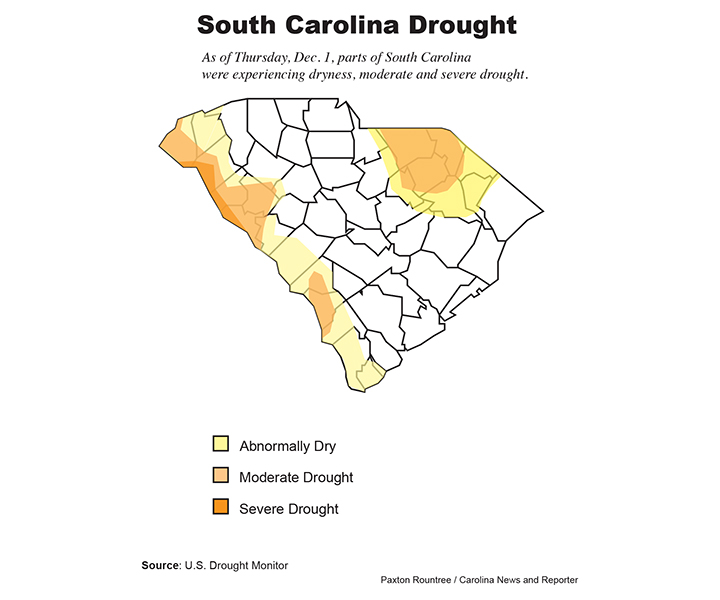A cloudy December sky over Columbia (Photo and graphics by Paxton Rountree)
Jason Roland uses molasses water to protect his plants when preparing for a cold winter.
Roland is the owner of Organically Roland Farm in Columbia. When preparing for the winter season, Roland has to figure out what kind of preparation he will need to ensure his plants will survive.
Molasses water is one way he said he can protect his plants against cold weather. But he might have to change his tactics this year.
This year marks the third La Niña year in a row. Because Roland chooses to grow outdoors through the winter, he has to prepare for a warmer winter than normal.
“Whenever you’re expecting a warmer winter for us, that’s really a good thing because most of winter is honestly just preparing for cold,” Roland said. “We can grow through the winter — we can grow through the cold weather.”
But La Niña also might mean less precipitation, so he will have to water his plants. He said it’s all about tweaking what the plants need so they’ll be more likely to survive.
While a normal La Niña year would suggest a warmer winter than normal, a La Niña occurring for a third year in a row is unprecedented.
So it’s difficult for forecasters to know what to expect.
A La Niña is when the ocean’s temperature is lower or colder than normal over the equatorial, eastern and central Pacific Ocean. This differs from an El Niño, which is when the ocean is warmer than normal.
Why would colder water temperatures cause warmer weather?
Pam Knox, an agricultural climatologist at the UGA Weather Network at the University of Georgia, said that the weather will be warmer and drier than usual because of how a La Niña affects the jet stream — the pattern of air that circles the globe, affecting seawater and weather patterns.
Knox said colder air at the equator throws off the jet stream, ultimately bringing in air that is warmer than usual.
This year’s different, of course.
Climatologist Frank Strait, the weather liaison at the South Carolina state climate office, has a name for this year’s La Niña.
“This ‘triple-dip’ case, where you have this long-lasting La Niña, tends to result in a different character of the winter overall,” Strait said.
But because a triple-dip has only happened twice in the recorded history of La Niña’s, Strait also said this could mean winter will turn out to be colder than normal. The recorded history of La Niña’s dates to 1975.
The winters of 1975-1976 and 2000-2001 were the only other recorded times with long-lasting La Niñas. Those years showed warmer Decembers, colder Januarys, and then back to warmer winter weather in February, Strait said.
But not all La Niñas last the same amount of time. And this year’s triple-dip is the longest lasting La Niña in recorded history.
Strait said that could mean South Carolina will experience a colder winter than normal for a La Niña — the opposite of what Roland said he was preparing for.
Knox disagrees with Strait.
She said a long-lasting La Niña is no different than a regular La Niña.
She’s anticipating the Southeastern United States will have a warm and dry winter.
“The statistics and the outlooks all give the same result — whether or not it’s a multi-year La Nina or it’s just the first,” Knox said.
Right now, parts of South Carolina are in an abnormal drought, which could worsen if the winter is warmer and drier than normal, according to the U.S. Drought Monitor, a federal agency.
Knox blames it on La Niña.
The National Weather Service also predicts this winter will be in line with Knox’s expectations.
Roland said he listens to his plants to decide what they need — no matter what the weather ends up being.
Despite the warmer winters the state has had for the better part of a decade, Roland said he prepares for unpredictable weather because he has seen a lot of it lately.
“You’ll have a month of decently nice weather, and then all of a sudden it is like one night where it drops to 20,” Roland said.
But he’s sticking to his expectations for a warm winter.
“We’re in South Carolina, so we can grow through the winter,” Roland said, smiling.





